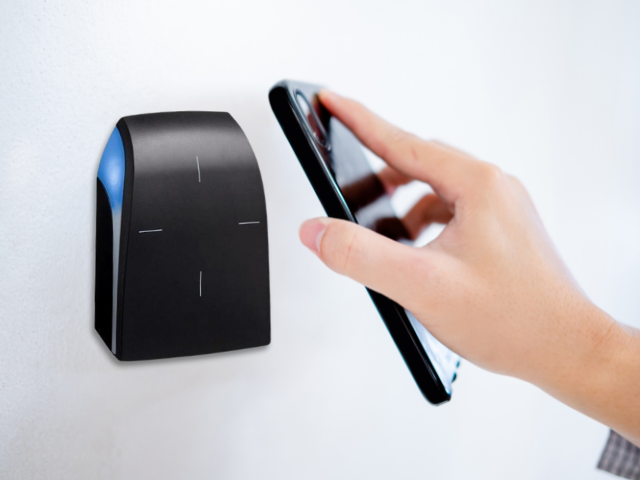Access Control Cards versus Mobile Credentials
21 October 2023

In the ever-evolving landscape of security systems, access control methods have undergone significant transformations, moving beyond traditional key-based mechanisms to embrace advanced technologies. Two prominent contenders in this domain are access control cards and mobile credentials. This article explores the characteristics, advantages, and challenges associated with each, offering insights into the ongoing debate over which method is more suitable for modern security needs.
Access Control Cards
Access control cards have been a staple in security systems for decades. These physical cards typically contain embedded information, such as magnetic stripes, barcodes, or RFID (Radio Frequency Identification) chips. The primary function of these cards is to grant or restrict access to a particular area based on the permissions encoded within them.
Advantages of Access Control Cards
There are several advantages to physical cards which for some sites makes them the perfect choice.
Proven Technology: Access control cards have a long history of reliability and effectiveness. Many organisations have successfully utilised them for years, attesting to their durability and efficiency.
Cost-Effective: Compared to some high-tech alternatives, access control cards are relatively cost-effective to implement. The infrastructure required to support card-based systems is often more budget-friendly than other sophisticated solutions.
Easy Integration: Access control cards can be easily integrated into existing security systems. This makes them a practical choice for organisations looking to upgrade their security without undergoing a complete overhaul.
Offline Capability: Access control cards often have offline capabilities, allowing them to function even when network connectivity is compromised. This offline functionality ensures a certain level of security continuity.
Challenges of Access Control Cards
Vulnerability to Loss or Theft: Physical cards are susceptible to loss or theft, posing a significant security risk. If an unauthorised individual gains possession of a card, they may be able to exploit it for unauthorised access.
Limited User Convenience: Users need to carry the physical card at all times, which can be inconvenient. Forgetting or misplacing the card can lead to delays and potential security breaches.
Limited Functionality: Traditional access control cards may offer limited functionality compared to their digital counterparts. They may lack features such as real-time updates and dynamic access permissions.
Mobile Credentials
With the rise of smartphones and mobile technology, mobile credentials have emerged as a contemporary alternative to access control cards. Mobile credentials leverage the power of smartphones to grant access, utilising technologies like Bluetooth, NFC (Near Field Communication), or mobile apps.
Advantages of Mobile Credentials
Enhanced Security: Mobile credentials often incorporate biometric authentication, such as fingerprint or facial recognition, adding an extra layer of security. This makes it more challenging for unauthorised individuals to gain access.
Convenience and Flexibility: Users appreciate the convenience of mobile credentials as they eliminate the need to carry physical cards. Access permissions can be easily managed and updated through a mobile app, offering unparalleled flexibility.
Remote Management: Mobile credentials enable administrators to manage access remotely. This feature is particularly useful for large organisations or those with multiple locations, allowing for efficient and centralised control.
Multi-Factor Authentication: Mobile credentials can support multi-factor authentication, combining something the user knows (password), something they have (the mobile device), and something they are (biometric data). This layered approach enhances overall security.
Challenges of Mobile Credentials:
Dependence on Technology: Mobile credentials rely on the functionality of smartphones. If a device is lost, damaged, or out of battery, users may face difficulties accessing secured areas.
Security Concerns: Some organisations may establish secure areas where personnel are restricted from carrying mobile phones. Vigilance is crucial to prevent potential security breaches linked to personnel possessing mobile phones in these secure areas; hence, access to these areas with mobile phones is deemed unsuitable.
Cost of Implementation: While the long-term benefits may outweigh the initial costs, the implementation of mobile credential systems can be expensive. Organisations need to invest in compatible infrastructure and ensure the security of the mobile credential ecosystem.
Compatibility Issues: Ensuring compatibility with a diverse range of smartphones and operating systems can be challenging. Organisations must address potential compatibility issues to provide a seamless experience for users.
Conclusion
In the ongoing debate between access control cards and mobile credentials, there is no one-size-fits-all solution. The choice between the two depends on the specific needs, budget constraints, and security priorities of the organisation. Access control cards bring a legacy of reliability and cost-effectiveness, while mobile credentials introduce advanced security features and unparalleled user convenience. Ultimately, the evolution of security systems is pushing organisations toward more sophisticated and integrated solutions. Hybrid approaches that combine the strengths of both access control cards and mobile credentials may emerge as the optimal strategy, providing a balance between reliability and cutting-edge technology. As technology continues to advance, security professionals must stay vigilant, adapting their systems to meet the ever-changing landscape of security threats and technological innovations. Fortunately, with the Entrowatch access control system both types of credential method can be used with Weigand compatible card readers.
